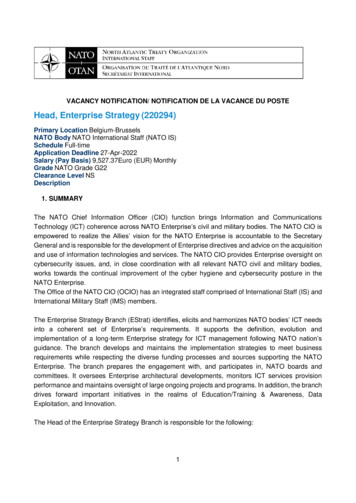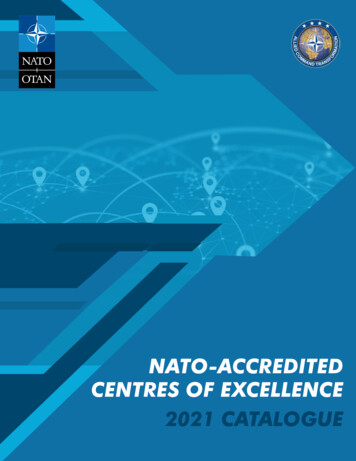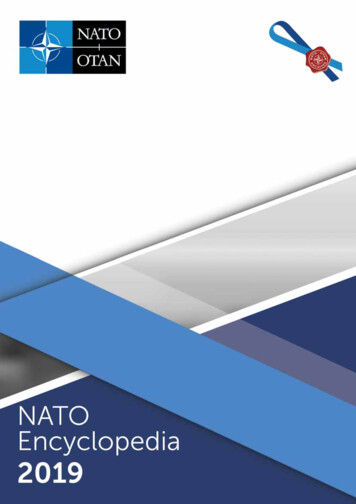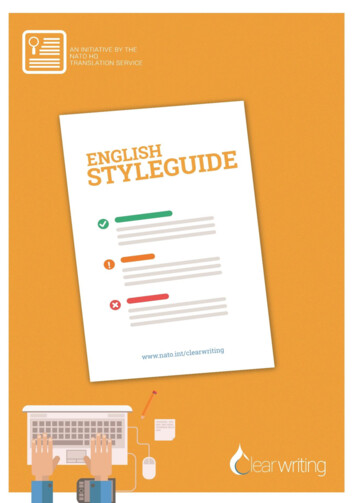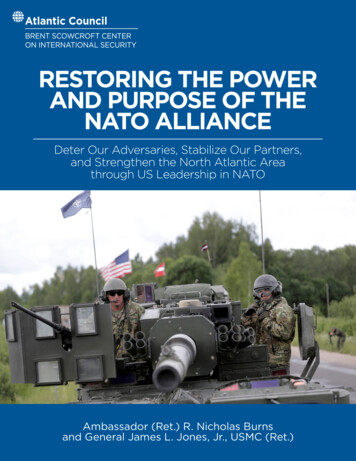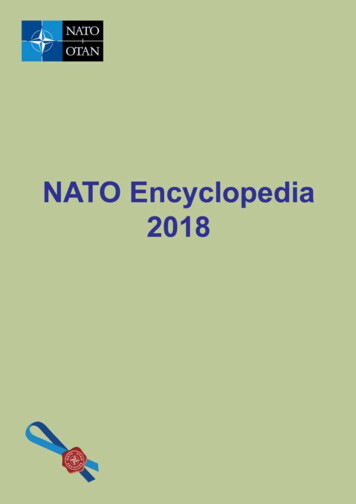
Transcription
This is a compilation of archived online topic pages which explain every aspect of NATO: its originand fundamental security tasks, policies and decision-making processes, peace support and crisismanagement operations and how the Alliance tackles threats and develops capabilities. They also coverNATO’s partnerships and cooperative activities, its civilian and military structures, and specialisedorganisations and agencies, as well as the Organization’s wider activities.The topic pages were archived as they appeared online on 12 December 2018.You can either access them via an alphabetical index, which provides a comprehensive list of all onlinetopic pages, or via a thematic overview, which groups the principal topics by area of interest.NATO Encyclopedia 2018For up-to-date information, please visit the cs.htmof NATO Topics online.NATO Public Diplomacy DivisionNATO HeadquartersBrussels, BelgiumDecember 20182
Alphabetical indexA– Accountability and transparency– Operation Active Endeavour (Archived)– NATO Administrative TribunalNATO Encyclopedia 2018– NATO Advisory and Liaison Team– Afghanistan and NATO– Resolute Support Mission in Afghanistan– NATO’s Senior Civilian Representative in Afghanistan– ISAF’s mission in Afghanistan (2001-2014) (Archived)– Inteqal: Transition to Afghan lead– SILK-Afghanistan– Cooperation with the African Union– Agencies and organisations– Integrated Air and Missile Defence– Air and Missile Defence Committee– NATO Airborne Early Warning and Control Programme Management Organisation– NATO Air Command and Control System– Air policing: securing NATO airspace– Alliance Ground Surveillance– Allied Command Operations– Supreme Allied Commander Europe– Allied Command Transformation– Supreme Allied Commander Transformation– Archives Committee– Arms control, disarmament and non-proliferation in NATO– NATO’s role in conventional arms control– High-Level Task Force on Conventional Arms Control– Atlantic Treaty Association and Youth Atlantic Treaty Association– Aviation Committee– AWACS: NATO’s ’eyes in the sky’December 20183
Alphabetical indexB– Ballistic missile defence– Boosting NATO’s presence in the east and southeast– Peace support operations in Bosnia and Herzegovina– Building integrityC– NATO’s capabilities– NATO Secretary General’s Special Representative for the Caucasus and Central Asia– Centres of Excellence– Chairman of the Military CommitteeNATO Encyclopedia 2018– Protection of children in armed conflict– Civil Emergency Planning Committee– Civil preparedness– Civilian Intelligence Committee– Protection of civilians– Collective defence and Article 5– Combined Joint Chemical, Biological, Radiological and Nuclear Defence Task Force– Committees– Committee for Standardization– Committee on Proliferation– Committee on Public Diplomacy– NATO Communications and Information Agency (NCI Agency)– Communications and public diplomacy– Comprehensive approach– Conference of National Armaments Directors– Connected Forces Initiative– Consensus decision-making at NATO– Consultation, Command and Control Board– The consultation process and Article 4– Contact Point Embassies– NATO’s role in Conventional arms control– High-Level Task Force on Conventional Arms Control– Council Operations and Exercises Committee– Countering terrorism– Counter-piracy operations (Archived)– Crisis management– Cyber defenceDecember 20184
Alphabetical indexD– Consensus decision-making at NATO– Defence Against Terrorism Programme of Work– Defence and Related Security Capacity Building Initiative– Defence Education Enhancement Programme– Information on defence expenditures– Defence Planning Process– Defence Policy and Planning Committee– NATO Defense College– Deputies Committee– Deterrence and defenceNATO Encyclopedia 2018– Disarmament, arms control and non-proliferation in NATOE– Economic analysis at NATO– Education and training– Electronic warfare– NATO’s role in energy security– Enlargement– Environment – NATO’s stake– Euro-Atlantic Disaster Response Coordination Centre– Euro-Atlantic Partnership– Euro-Atlantic Partnership Council– Relations with the European Union– ExercisesF– Peace support operations in the former Yugoslav Republic of Macedonia1– Founding treaty– Funding NATOG– Gender balance and diversity in NATO– Gender perspectives in NATO Armed ForcesH– Harmel Report– NATO Headquarters– High-Level Task Force on Conventional Arms Control– NATO’s response to hybrid threats1Turkey recognises the Republic of Macedonia with its constitutional name.December 20185
Alphabetical indexI– Improvised explosive devices– Individual Partnership Action Plans– Integrated Air and Missile Defence– Building integrity– Inteqal: Transition to Afghan lead– International Board of Auditors for NATO– International Military Staff– International Staff– Interoperability: Connecting NATO Forces– NATO and the 2003 campaign against Iraq (Archived)NATO Encyclopedia 2018– NATO’s assistance to Iraq (Archived)– ISAF’s mission in Afghanistan (2001-2014) (Archived)– Istanbul Cooperation InitiativeJ– Joint Intelligence, Surveillance and ReconnaissanceK– Kosovo Air Campaign (Archived)– NATO’s role in KosovoL– Libya and NATO (Archived)– Logistics– Logistics CommitteeM– Maritime activities– Medical support– Mediterranean Dialogue– Member countries– Membership Action Plan– Meteorology and oceanography– Military Committee– Chairman of the Military Committee– Military organisation and structures– Missions and operations: past and presentN– National delegations to NATO– NATO Administrative Tribunal– NATO Advisory and Liaison Team– NATO Communications and Information Agency (NCI Agency)December 20186
Alphabetical index– NATO Defense College– NATO-Georgia Commission– NATO Information and Documentation Centre in Kyiv, Ukraine– NATO Information Office in Moscow– NATO Liaison Office in Georgia– NATO Liaison Office in Ukraine– NATO Military Liaison Mission in Moscow– NATO Office of Resources– NATO Parliamentary Assembly– NATO Response Force– NATO-Russia CouncilNATO Encyclopedia 2018– NATO Support and Procurement Agency– NATO-Ukraine Commission– NATO-Ukraine Joint Working Group on Defence Reform– Non-proliferation, arms control and disarmament in NATO– North Atlantic Cooperation Council (Archived)– North Atlantic Council– Nuclear deterrence policy and forces– Nuclear Planning GroupO– Oceanography and meteorology– NATO Office of Resources– Operations and missions: past and present– Operation Active Endeavour (Archived)– Operation Sea Guardian– Operations Policy Committee– Organisations and agencies– Relations with the OSCEP– Pakistan earthquake relief operation– NATO Parliamentary Assembly– Relations with partners across the globe– Partnerships : projecting stability through cooperation– Partnership for Peace programme– Partnership for Peace Planning and Review Process– Partnership for Peace Status of Forces Agreement– Partnership Interoperability Initiative– Partnership tools– Partnerships and Cooperative Security Committee– Peace support operations in Bosnia and HerzegovinaDecember 20187
Alphabetical index– Peace support operations in the former Yugoslav Republic of Macedonia1– NATO Pipeline System– Central Europe Pipeline System– Central Europe Pipeline System Programme Board– Counter-piracy operations (Archived)– Political Committee– Committee on Proliferation– Protection of children in armed conflict– Protection of civilians– Public diplomacy and communications– Committee on Public DiplomacyNATO Encyclopedia 2018– Public disclosure of NATO information– NATO’s purposeR– Rapid Deployable Corps– Readiness Action Plan– Reform– Assistance for the refugee and migrant crisis in the Aegean Sea– Report of the Committee of Three– Reserve forces– Resource Policy and Planning Board– Relations with Armenia– Relations with Australia– Relations with Austria– Relations with Azerbaijan– Relations with Belarus– Relations with Bosnia and Herzegovina– Relations with Colombia– Relations with the European Union– Relations with Finland– Relations with the former Yugoslav Republic of Macedonia1– Relations with Georgia– NATO-Georgia Commission– NATO Liaison Office Georgia– Relations with Iraq– Relations with Ireland– Relations with Japan– Relations with Kazakhstan– Relations with the Republic of Korea1Turkey recognises the Republic of Macedonia with its constitutional name.December 20188
Alphabetical index– Relations with the Kyrgyz Republic– Relations with Malta– Relations with the Republic of Moldova– Relations with Mongolia– Relations with New Zealand– Relations with the OSCE– Relations with Pakistan– Relations with partners across the globe– Relations with Russia– NATO-Russia Council– NATO Information Office in MoscowNATO Encyclopedia 2018– NATO Military Liaison Mission Moscow– Relations with Serbia– Relations with Sweden– Relations with Switzerland– Relations with Tajikistan– Relations with Turkmenistan– Relations with Ukraine– NATO-Ukraine Commission– NATO-Ukraine Joint Working Group on Defence Reform– NATO Information and Documentation Centre in Kyiv, Ukraine– NATO Liaison Office in Ukraine– Relations with the United Nations– Relations with Uzbekistan– Resilience and Article 3– Resolute Support Mission in Afghanistan– NATO Response ForceS– SATCOM Post-2000– Science and Technology Organization– Science for Peace and Security Programme– Operation Sea Guardian– NATO Secretary General– Security Committee– NATO’s Senior Civilian Representative in Afghanistan– SILK-Afghanistan– Situation Centre– Small arms and light weapons (SALW) and mine action (MA)– Smart Defence– Special Operations Forces– StandardizationDecember 20189
Alphabetical index– Committee for Standardization– Standardization Office– Strategic Concepts– Strategic airlift– Strategic sealift– Summit meetings– NATO Support and Procurement Agency– Supreme Allied Commander Europe– Supreme Allied Commander TransformationTNATO Encyclopedia 2018– Countering terrorism– NATO policy on combating trafficking in human beings– Training and education– Transparency and accountability– Founding treaty– Troop contributions– Trust FundsU– Relations with the United NationsV– Verification Coordinating CommitteeW– Weapons of mass destruction– Women, Peace and SecurityDecember 201810
Thematic overviewIntroduction to NATONATO Encyclopedia 2018Understand how and why NATO was created, itsfundamental security tasks and the main policies andprinciples that guide the Organization.NATO basicsPolicy and decision-making– NATO’s purpose– Consensus decision-making at NATO– The founding treaty– The consultation process and Article 4– Member countries– Summit meetings– Defence Planning ProcessFundamental security tasks– Collective defence - Article 5– Crisis management– Partnerships: projecting stability throughcooperation– Strategic Concepts– Deterrence and defence– NATO’s nuclear deterrence policy and forces– Committees– North Atlantic Council (NAC)– Nuclear Planning Group (NPG)– Military Committee (MC)Opening up of Alliance membership– Enlargement– Membership Action Plan (MAP)Financial resources and transparency– Funding NATO– Transparency and accountability– Information on defence expenditures– Public disclosure of NATO informationDecember 201811
Thematic overviewCrisis Management OperationsNATO Encyclopedia 2018Get a comprehensive overview of NATO-ledoperations and missions, past and present, large andsmall, conducted across several continents.Operations– Operations and missions: past and present– NATO and Afghanistan– NATO’s role in Kosovo– Operation Sea Guardian– Counter-piracy operations (Archived)– Operation Active Endeavour (Archived)– NATO and Libya (Archived)– NATO’s assistance to Iraq (Archived)– Troop contributions– Reserve forcesOther activities and missions– NATO’s maritime activities– Assistance for the refugee and migrant crisis in the Aegean Sea– Assistance to the African Union– Peace support operations in Bosnia and Herzegovina– Peace support operations in the former Yugoslav Republic of Macedonia11Turkey recognises the Republic of Macedonia with its constitutional name.December 201812
Thematic overviewSecurity Challenges and CapabilitiesNATO Encyclopedia 2018Read more about today’s security challenges and thedefence capabilities NATO is developing to tacklethem such as missile defence or Alliance GroundSurveillance.Security challenges– Cyber defence– Countering terrorism– Education and training– Weapons of mass destruction– Electronic warfare– Ballistic missile defence– Exercises– Cyber defence– Joint Intelligence, Surveillance andReconnaissance– Improvised explosive devices– Logistics– Energy security– Medical support– Environment – NATO’s stake– Meteorology and oceanography– NATO’s response to hybrid threatsCapabilities– NATO Air Command and Control System(ACCS)– NATO Integrated Air and Missile Defence– NATO’s Capabilities– NATO Pipeline System– Air policing: securing NATO airspace– NATO Response Force– Alliance Ground Surveillance (AGS)– Rapid Deployable Corps– AWACS: NATO’s ’eyes in the sky’– Readiness Action Plan– Ballistic missile defence– Resilience and Article 3– Boosting NATO’s presence in the east andsoutheast– Smart Defence– Centres of Excellence– Special Operations Forces– Civil preparedness– Standardization– Combined Joint Chemical, Biological,Radiological and Nuclear Defence Task Force– Strategic airlift– Connected Forces Initiative– Weapons of mass destruction– Strategic sealift– Countering terrorismDecember 201813
Thematic overviewPartnership and CooperationNATO Encyclopedia 2018Learn more about how NATO works with a network ofover 40 non-member countries as well as otherorganisations to promote security and tackle sharedchallenges.– Partnerships: projecting stability throughcooperationFrameworks and tools for cooperationwith partners––––––––The Euro-Atlantic PartnershipPartnership for Peace programmeMediterranean DialogueIstanbul Cooperation Initiative (ICI)Relations with partners across the globePartnership Interoperability InitiativePartnership toolsDefence and Related Security CapacityBuilding Initiative– Contact Point Embassies in partner countriesRelations with individual ��––Relations with KazakhstanRelations with the Republic of KoreaRelations with the Kyrgyz RepublicRelations with MaltaRelations with the Republic of MoldovaRelations with MongoliaRelations with New ZealandRelations with PakistanRelations with RussiaRelations with SerbiaRelations with SwedenRelations with SwitzerlandRelations with TajikistanRelations with the former Yugoslav Republic ofMacedonia1– Relations with Turkmenistan– Relations with Ukraine– Relations with UzbekistanRelations with other –––––NATO and AfghanistanRelations with ArmeniaRelations with AustraliaRelations with AustriaRelations with AzerbaijanRelations with BelarusRelations with Bosnia and HerzegovinaRelations with ColombiaRelations with FinlandRelations with GeorgiaRelations with IraqRelations with IrelandRelations with Japan1Turkey recognises the Republic of Macedonia with its constitutional name.––––––Comprehensive approachRelations with the United NationsRelations with the European UnionRelations with the OSCENATO Parliamentary AssemblyAtlantic Treaty Association and Youth AtlanticTreaty AssociationDecember 201814
Thematic overviewCivilian and Military StructuresNATO Encyclopedia 2018See how 29 countries work together through arelatively small number of structures that interact on adaily basis and are bound together by the principle ofconsensus decision-making.Principal policy and decision-makingbodies– North Atlantic Council (NAC)– Nuclear Planning Group (NPG)Principal organisations and agencies– Organisations and agencies– NATO Communications and InformationAgency (NCI Agency)– Military Committee (MC)– NATO Support and Procurement Agency(NSPA)Civilian organisation and functions– NATO Science and Technology Organization– Committees– NATO Standardization Office (NSO)– NATO Secretary General– International Staff– NATO HeadquartersMilitary organisation and functions– Military organisation and structures– Military Committee (MC)– Chairman of the Military Committee– International Military Staff (IMS)– Allied Command Operations (ACO)– Supreme Allied Commander Europe(SACEUR)– Allied Command Transformation (ACT)– Supreme Allied Commander Transformation(SACT)December 201815
Thematic overviewWider ActivitiesNATO Encyclopedia 2018Discover other areas in which NATO is involved suchas disarmament, arms control and non-proliferation,energy security, science and gender issues.Arms control and disarmament– NATO’s role in conventional arms control– Arms control, disarmament and non-proliferation in NATO– Small arms and light weapons (SALW) and mine action (MA)Countering human trafficking during military operations– NATO policy on combating trafficking in human beingsEconomic dimension of security– Economic analysis at NATOGender issues– Women, Peace and Security– Gender balance and diversity in NATO– Gender perspectives in NATO Armed ForcesPublic diplomacy– Communications and public diplomacyScience, research and technology– Science for Peace and Security– NATO Science and Technology Organization– Energy security– Environment – NATO’s stakeDecember 201816
NATO and AfghanistanNATO Encyclopedia 2018NATO is leading a non-combat mission to train, advise and assist the Afghan security forces and institutions.The Resolute Support Mission (RSM) was launched in January 2015, following the completion of themission of the International Security Assistance Force (ISAF) in December 2014, when responsibility forsecurity in Afghanistan was transferred to the Afghan national defence and security forces. Beyondsupporting RSM, NATO Allies and partners are helping to sustain Afghan security forces and institutionsfinancially, as part of a broader international commitment to Afghanistan. The NATO-Afghanistan EnduringPartnership provides a framework for wider political dialogue and practical cooperation.n NATO led the UN-mandated International Security Assistance Force (ISAF) from August 2003 toDecember 2014. ISAF’s mission was to enable the Afghan authorities and build the capacity of theAfghan national security forces to provide effective security, so as to ensure that Afghanistan wouldnever again be a safe haven for terrorists.n ISAF is NATO’s longest and most challenging mission to date: at its height, the force was more than130,000 strong with troops from 50 NATO and partner nations.n ISAF also contributed to reconstruction and development in Afghanistan through 28 multinationalProvincial Reconstruction Teams – led by individual ISAF nations – securing areas, outside of Kabulin the provinces, in which reconstruction work was conducted by national and international actors.n The transition to Afghan lead for security started in 2011 and was completed in December 2014,when the ISAF operation ended and the Afghans assumed full responsibility for security of theircountry. By the end of 2014, PRTs had been phased out and their functions were handed over toBack to indexDecember 201817
NATO and AfghanistanAfghan authorities. In January 2015, NATO launched the Resolute Support Mission (RSM) to train,advise and assist Afghan security forces and institutions. Currently, it numbers over 16,000 troopsfrom 39 NATO Allies and partner countries.n Allied leaders decided at the July 2016 NATO Summit in Warsaw to sustain the presence of RSMbeyond 2016.NATO Encyclopedia 2018n At the July 2018 NATO Summit in Brussels, NATO welcomed two new troop-contributing nations, theUnited Arab Emirates and Qatar, which are currently finalising the details of their offers to contribute.The Allies and their operational partners committed to sustaining the mission until conditionsindicate a change is appropriate; to extending financial sustainment of the Afghan security forcesthrough 2024; and to making further progress on developing a political and practical partnership withAfghanistan.n The Enduring Partnership is NATO’s political partnership with Afghanistan. It was set up in 2010 atthe NATO Summit in Lisbon. At the 2016 Summit, Allies decided to strengthen and enhance thePartnership, within and alongside RSM, through political dialogue and practical cooperation. In thelonger term, a traditional partnership with Afghanistan remains NATO’s goal.n NATO’s Senior Civilian Representative represents the political leadership of the Alliance in Kabul,liaising with the government, civil society, representatives of the international community andneighbouring countries. The Representative has a leading role in advising the Afghan authorities onthe Enduring Partnership.More background informationResolute Support MissionLaunched on 1 January 2015, the Resolute Support Mission (RSM) focuses primarily on training, adviceand assistance activities at the security-related ministries, in the country’s institutions and among thesenior ranks of the army and police. The Resolute Support Mission works closely with different elementsof the Afghan army, police and air force.Back to indexDecember 201818
NATO and AfghanistanThe mission performs supporting functions in several areas. These include operational planning;budgetary development; force generation process; management and development of personnel;logistical sustainment; and civilian oversight to ensure the Afghan national defence and security forcesand institutions act in accordance with the rule of law and good governance.As of July 2018, RSM has over 16,000 personnel from 39 NATO Allies and partner countries, operating inone hub (Kabul/Bagram) and four spokes (Mazar-e Sharif in the north, Herat in the west, Kandahar in thesouth, and Laghman in the east).The Afghan forces are making progress, performing with professionalism and bravery across the country,and continuing to deny the insurgents their strategic goals. They are developing their combat capabilities,notably their Special Operations Forces and the Air Force.NATO Encyclopedia 2018(More on Resolute Support)Financial sustainment of the Afghan National Defence andSecurity ForcesAt the Wales Summit in 2014, Allied leaders and their international partners renewed the pledge madeearlier at the Chicago Summit to play their part in the financial sustainment of the Afghan NationalDefence and Security Forces (ANDSF) after 2014. The responsibility to contribute to the financing of thiseffort is one for the international community as a whole.NATO has participated in that process, by supporting development of transparent, accountable andcost-effective international funding mechanisms and expenditure arrangements for all strands of theANDSF.As of 28 May 2018, total contributions made to the NATO-Afghan National Army (ANA) Trust Fund amountto more than USD 2.3 billion. The Afghan government itself is also expected to provide at least USD 500million per year for the sustainment of the ANDSF. (More on the ANA Trust Fund )The ANA Trust Fund is one of four funding streams used to channel financial support to Afghanistan’ssecurity forces and institutions. The other three are the Law and Order Trust Fund for Afghanistan(LOTFA), administered by the United Nations Development Programme; the United States AfghanistanSecurity Forces Fund (ASFF); and the Afghan government’s commitment to providing USD 500 millioneach year, while attempting to increase this amount annually, until they can financially sustain their ownforces. LOTFA is used to pay the salaries of police and justice personnel and to build the capacity of theministry of interior. The ASFF is subject to a US-Afghan bilateral agreement and pays for equipping andrunning Afghanistan’s security forces.In December 2015, NATO Allies and partners launched further work with the wider internationalcommunity to ensure that the ANDSF could be financially sustained through 2020. Heads of state andgovernment made this commitment at the NATO Summit in Warsaw in July 2016. Allies and theiroperational partners agreed to extend financial sustainment of the Afghan security forces through 2024.NATO’s Enduring Partnership with AfghanistanNATO and Afghanistan signed a Declaration on Enduring Partnership at the 2010 NATO Summit inLisbon. The document provides a framework for long-term political consultations and practicalcooperation in areas of specific interest for Afghanistan where NATO can share expertise.The initial set of Enduring Partnership activities, agreed by foreign ministers in April 2011, brings togethera number of previously separate initiatives. The Enduring Partnership will contribute to NATO’s evolvingmission and the sustained development of Afghan institutions.In May 2015, NATO foreign ministers approved guidelines and principles for the enhancement of theEnduring Partnership. These include a continued presence of civilian and military personnel on theground after the current Resolute Support Mission. In the longer term, the Enduring Partnership is alsointended as a bridge towards a more traditional partnership between NATO and Afghanistan.Back to indexDecember 201819
NATO and AfghanistanCooperation within this framework includes:n capacity-building efforts, such as NATO’s Building Integrity (BI) programme, which is helping to provideAfghanistan with practical tools to strengthen integrity, transparency and accountability and reduce therisk of corruption in defence and security sectors;n professional military education programmes, such as the Defence Education EnhancementProgramme (DEEP);n training in civil emergency planning and disaster preparedness;n public diplomacy efforts to promote a better understanding of NATO and its role in Afghanistan.NATO Encyclopedia 2018ISAF’s mission (2001 – 2014)Deployed in 2001 – initially under the lead of individual NATO Allies on a six-month rotational basis – ISAFwas tasked, on the request of the Afghan government and under a United Nations (UN) mandate, to assistthe Afghan government in maintaining security, originally in and around Kabul exclusively. NATO agreedto take command of the force in August 2003 and the UN Security Council subsequently mandated thegradual expansion of ISAF’s operations to cover the whole country.ISAF was one of the largest coalitions in history. It is NATO’s longest and most challenging mission todate. At its height, the force was more than 130,000 strong with troops from 50 NATO and partner nations.As part of the international community’s overall effort, ISAF worked to create the conditions whereby theAfghan government would be able to exercise its authority throughout the country.Developing professional, capable and self-sustaining Afghan National Security Forces was at the centreof ISAF’s efforts and the core mission of the NATO Training Mission in Afghanistan (NTM-A). This workwas carried out in close cooperation with the European Union Police Mission in Afghanistan (EUPOLAfghanistan) and the Afghan Ministry of Defence. The NTM-A, which was set up in 2009, focused ontraining initial recruits and building the institutional training capability of the Afghan security forces, whilethe ISAF Joint Command was responsible for developing fielded units through advice and assistance.These combined efforts helped build up the Afghan security forces from scratch to approximately 352,000soldiers and police officers. Since its creation in 2002, the Afghan National Army (ANA) incrementallyprogressed from an infantry-centric force to an army, with both fighting elements and enabling capabilities– such as military police, intelligence, route clearance, combat support, medical, aviation and logistics.The role of the Afghan National Police (ANP) gradually shifted from countering the insurgency to a morecivilian policing role, by further developing capabilities ranging from criminal investigations to trafficcontrol. The Afghan Air Force steadily increased its personnel including civilians as well as military aircrewand maintenance and support personnel, and its fleet of fixed-wing and rotary-wing aircraft.A gradual process of transition to full Afghan security responsibility – known as “Inteqal” in Dari andPashtu – was launched in 2011. This process was completed on schedule in December 2014, whenISAF’s mission ended and the Afghan forces assumed full security responsibility for their country.ISAF helped create a secure environment for improving governance and socio-economic development,which are important conditions for sustainable stability. Afghanistan made the largest percentage gain ofany country in basic health and development indicators over the decade of ISAF’s mission. Maternalmortality went down and life expectancy rose. A vibrant media scene sprang up. Millions of people haveexercised their right to vote in five election cycles since 2004, including the 2014 presidential andprovincial council elections, which resulted in the establishment of a National Unity Government.(More on ISAF’s mission)A collective international effortAddressing Afghanistan’s challenges requires a comprehensive approach, involving civilian and militaryactors, aimed not only at providing security but also at promoting good governance, the rule of law andlong-term development. The Alliance acts in a supporting role to the Afghan government and works inBack to indexDecember 201820
NATO and Afghanistanclose coordination with other international partners, including the United Nations Assistance Mission inAfghanistan (UNAMA), the World Bank, the European Union and the development community.From the start of NATO’s engagement in international efforts to help secure Afghanistan’s future, theAlliance has also worked closely with many non-member countries. ISAF troop contributors includedpartners from as far afield as Australia and Latin America, representing more than a quarter of UNmember countries, u
- Air policing: securing NATO airspace - Alliance Ground Surveillance (AGS) - AWACS: NATO's 'eyes in the sky' - Ballistic missile defence - Boosting NATO's presence in the east and southeast - Centres of Excellence - Civil preparedness - Combined Joint Chemical, Biological, Radiological and Nuclear Defence Task Force
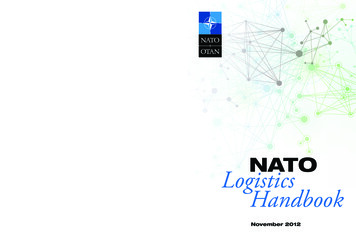
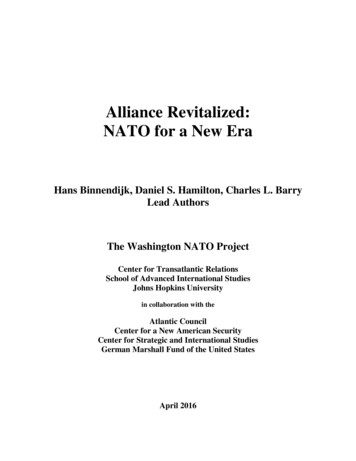
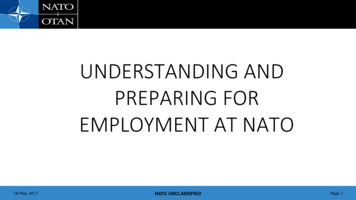
![Encyclopedia of Brazilian Jiu Jitsu: Volume 2 [Pdf] - Rigan Machado (2022)](/img/62/encyclopedia-20of-20brazilian-20jiu-20jitsu-20volume-202-20pdf.jpg)
